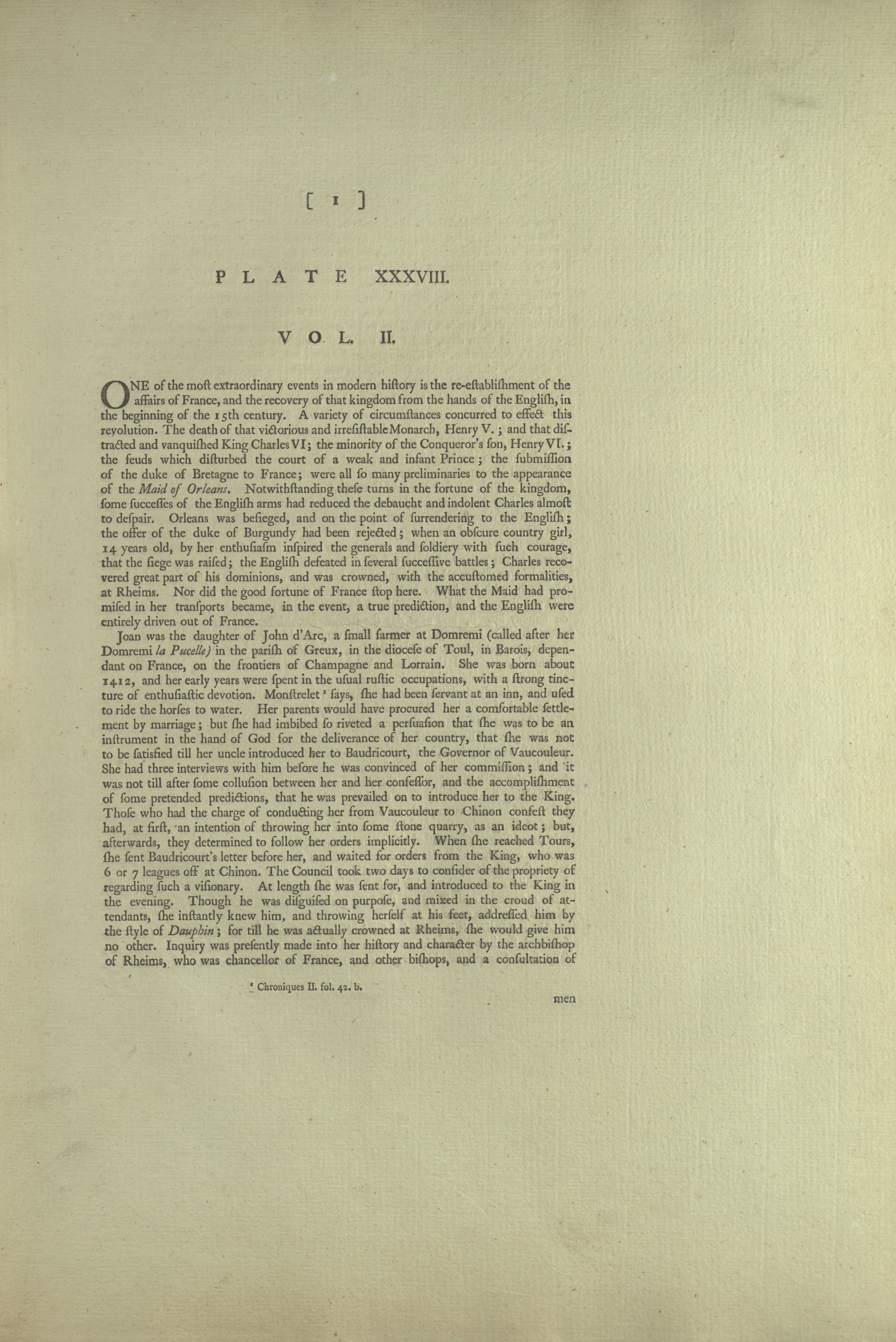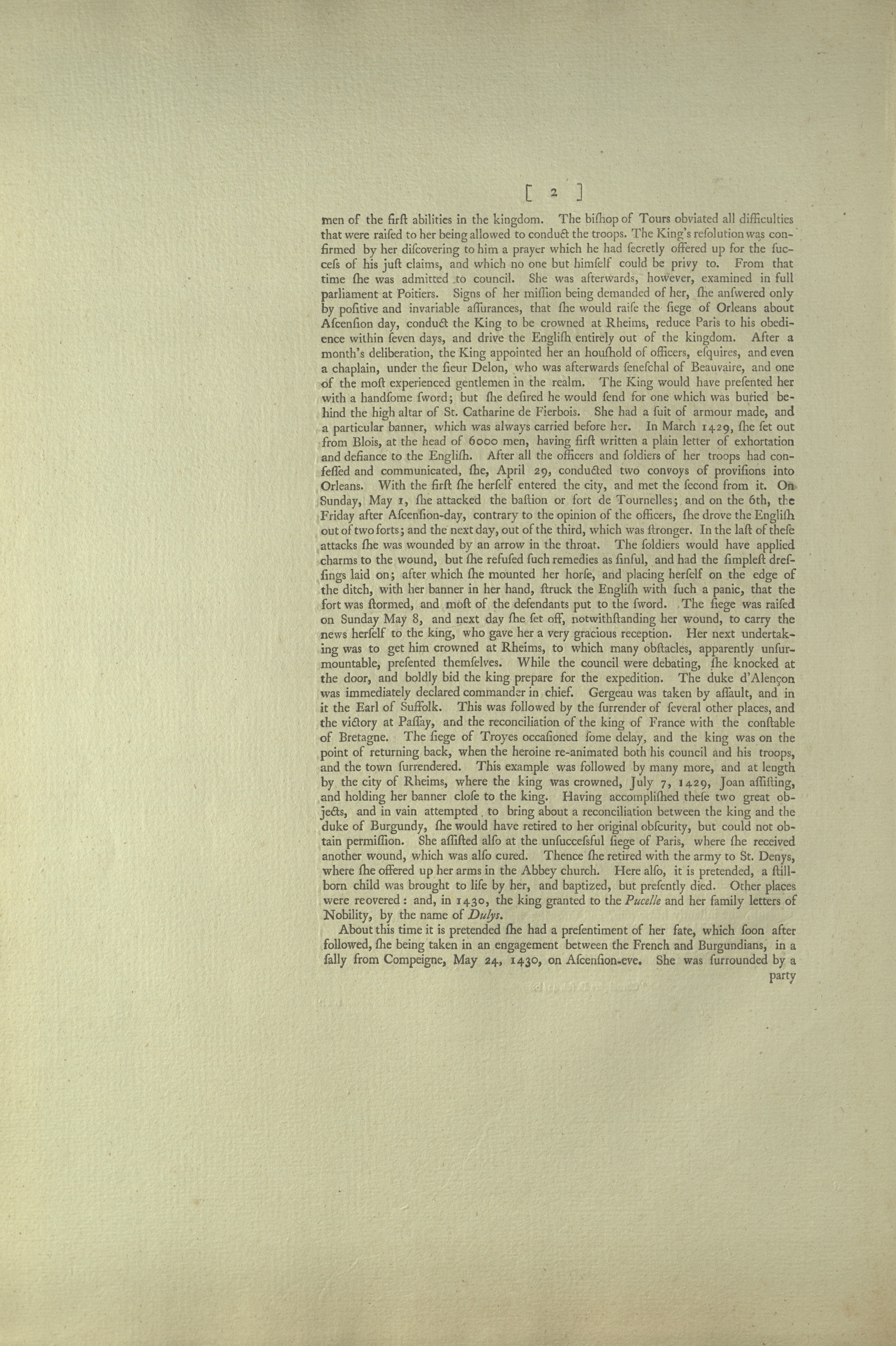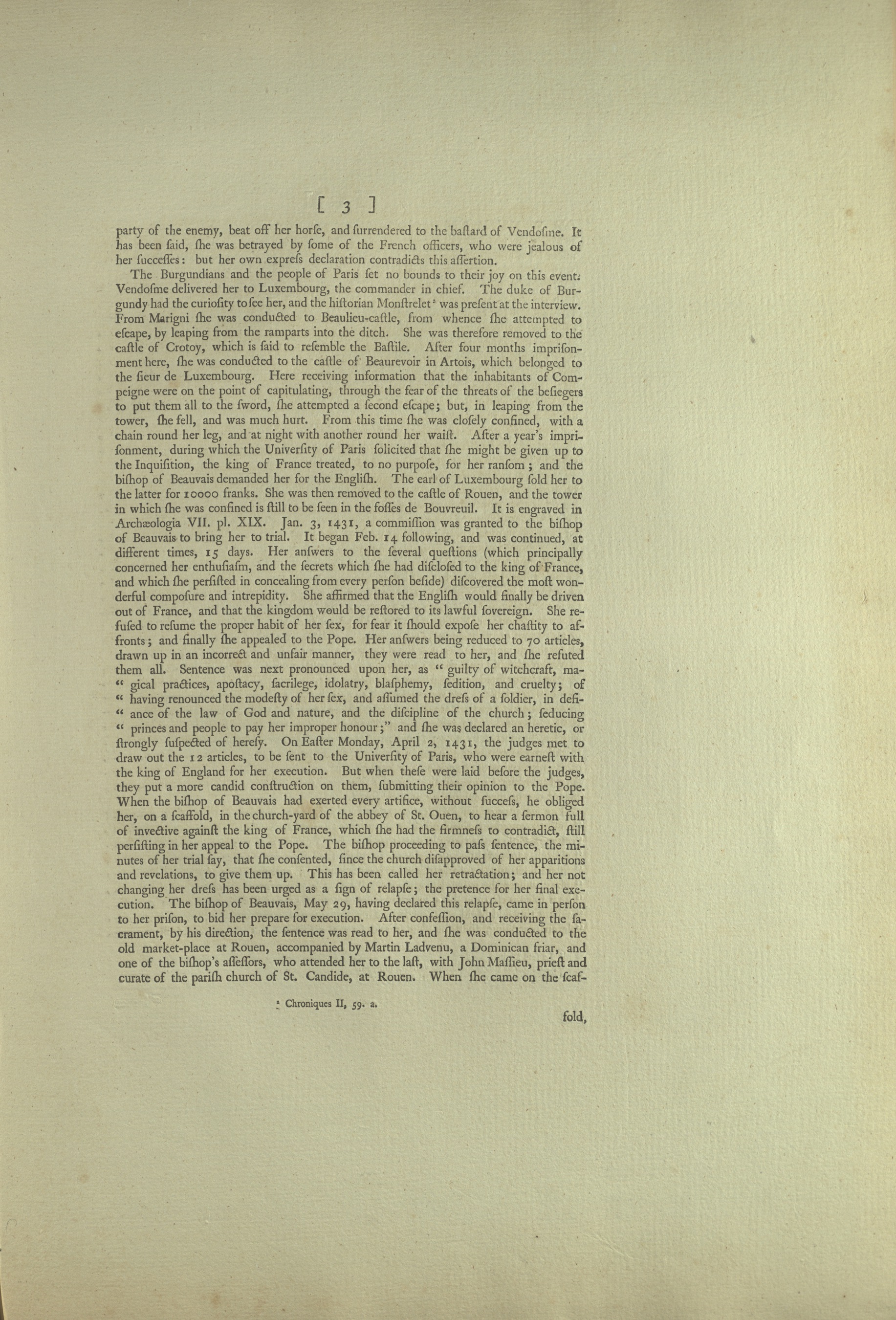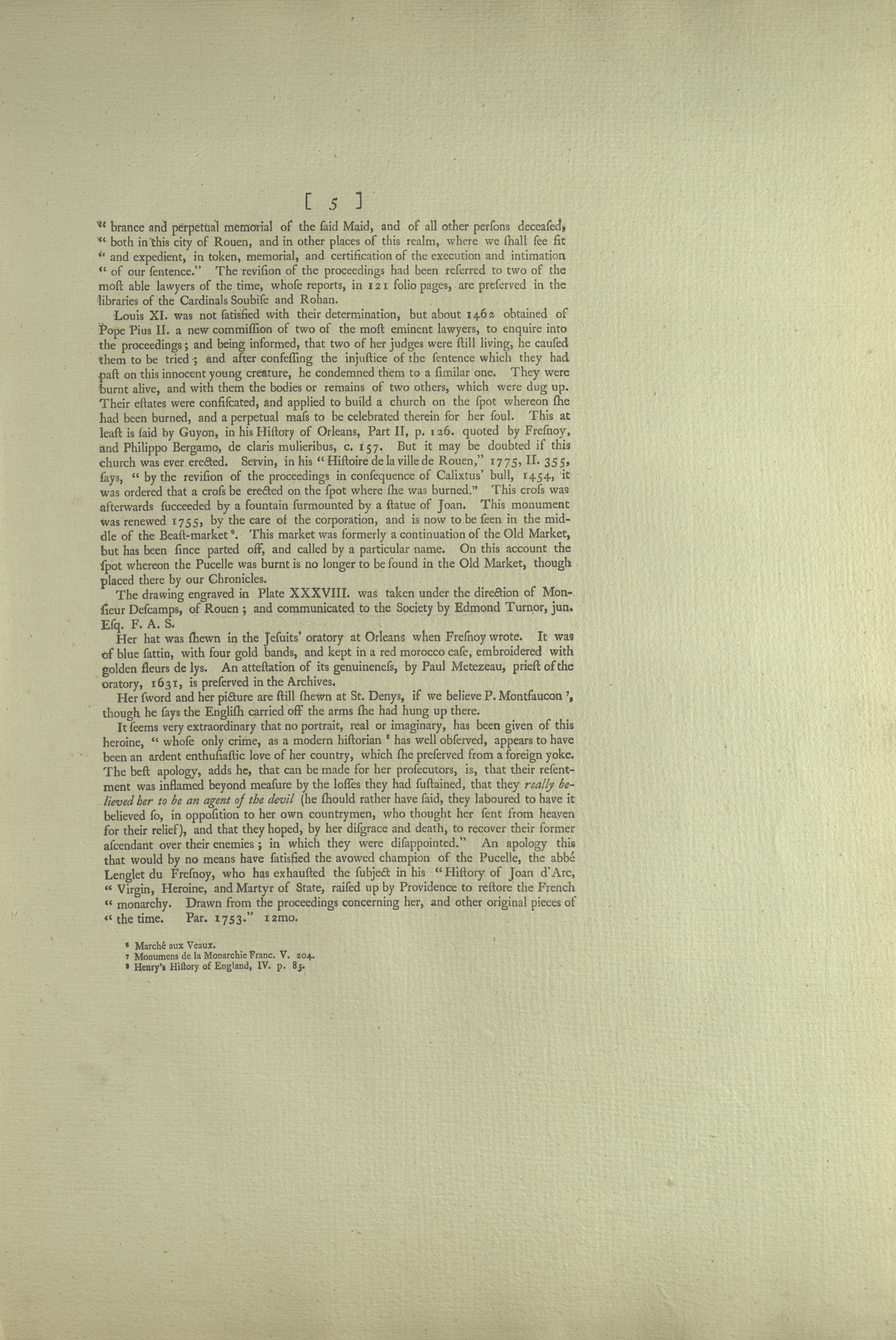
Creative Commons Attribution-Noncommercial-No Derivative Works 3.0
Plate 2.38: Fountain at Rouen, Dedicated to Joan of Arc (Original Explanatory Account)
1 2020-07-02T14:13:09+00:00 Ariel Fried f6b6cec26c5a46c3beae9e3505bac9e8799f51de 31 31 Original Explanatory Account for Vetusta Monumenta, Plate 2.38. Written by Richard Gough. plain 2021-05-05T23:44:50+00:00 Ariel Fried f6b6cec26c5a46c3beae9e3505bac9e8799f51de
[ (Page) 1 ]
PLATE XXVIII
VOL.II
ONE of the most extraordinary events in modern history is the re-establishment of the affairs of France, and the recovery of that kingdom from the hands of the English, in the beginning of the 15th century.
Read more/less...A variety of circumstances concurred to effect this revolution. The death of that victorious and irresistable Monarch, Henry V.; and that distracted and vanquished King Charles VI; the minority of the Conqueror’s son, Henry VI.; the feuds which disturbed the court of a weak and infant Prince; the submission of the duke of Bretagne to France; were all so many preliminaries to the appearance of the Maid of Orleans. Notwithstanding these turns in the fortune of the kingdom, some successes of the English arms had reduced the debaucht and indolent Charles almost to despair. Orleans was besieged, and on the point of surrendering to the English; the offer of the duke of Burgundy had been rejected; when an obscure country girl, 14 years old, by her enthusiasm inspired the generals and soldiery with such courage, that the siege was raised; the English defeated in several successive battles; Charles recovered great part of his dominions, and was crowned, with the accustomed formalities, at Rheims. Nor did the good fortune of France stop here. What the Maid had promised in her transports became, in the event, a true prediction, and the English were entirely driven out of France.
Joan was the daughter of John d’Arc, a small farmer at Domremi (called after her Domremi la Pucelle) in the parish of Greux, in the diocese of Toul, in Barois, dependant on France, on the frontiers of Champagne and Lorrain. She was born about 1412, and her early years were spent in the usual rustic occupations, with a strong tincture of enthusiastic devotion. Monstrelet1 says, she had been [a] servant at an inn, and used to ride the horses to water. Her parents would have procured her a comfortable settlement by marriage; but she had imbibed so riveted a persuasion that she was to be an instrument in the hand of God for the deliverance of her country, that she was not to be satisfied till her uncle introduced her to Baudricourt, the Governor of Vaucouleur. She had three interviews with him before he was convinced of her commission; and it was not till after some collusion between her and her confessor, and the accomplishment of some pretended predictions, that he was prevailed on to introduce her to the King. Those who had the charge of conducting her from Vaucouleur to Chinon confest they had, at first, an intention of throwing her into some stone quarry, as an ideot; but, afterwards, they determined to follow her orders implicitly. When she reached Tours, she sent Baudricourt’s letter before her, and waited for orders from the King, who was 6 or 7 leagues off at Chinon. The Council took two days to consider the propriety of regarding such a visionary. At length she was sent for, and introduced to the King in the evening. Though he was disguised on purpose, and mixed in the croud of attendants, she instantly knew him, and throwing herself at his feet, addressed him by the style of Dauphin; for till he was actually crowned at Rheims, she would give him no other. Inquiry was presently made into her history and character by the archbishop of Rheims, who was chancellor of France, and other bishops, and a consultation of
1 Chroniques II. fol. 42. b.

[ (Page) 2 ]
men of the first abilities in the kingdom. The bishop of Tours obviated all difficulties that were raised to her being allowed to conduct the troops. The King’s resolution was confirmed by her discovering to him a prayer which he had secretly offered up for the success of his just claims, and which no one but himself could be privy to.
Read more/less...From that time she was admitted to council. She was afterwards, however, examined in full parliament at Poitiers. Signs of her mission being demanded of her, she answered only by positive and invariable assurances, that she would raise the siege of Orleans about Ascension day, conduct the King to be crowned at Rheims, reduce Paris to his obedience within seven days, and drive the English entirely out of the kingdom. After a month’s deliberation, the King appointed her an houshold of officers, esquires, and even a chaplain, under the sieur Delon, who was afterwards seneschal of Beauvaire, and one of the most experienced gentlemen in the realm. The King would have presented her with a handsome sword; but she desired he would send for one which was buried behind the high altar of St. Catharine de Fierbois. She had a suit of armour made, and a particular banner, which was always carried before her. In March 1429, she set out from Blois, at the head of 6000 men, having first written a plain letter of exhortation and defiance to the English. After all the officers and soldiers of her troops had confessed and communicated, she, April 29, conducted two convoys of provisions into Orleans. With the first she herself entered the city, and met the second from it. On Sunday, May 1, she attacked the bastion or fort de Tournelles; And on the 6th, the Friday after Ascension-day, contrary to the opinion of the officers, she drove the English out of two forts; and the next day, out of the third, which was stronger. In the last of these attacks she was wounded by an arrow in the throat. The soldiers would have applied charms to the wound, but she refused such remedies as sinful, and had the simplest dressings laid on; after which she mounted her horse, and placing herself on the edge of the ditch, with her banner in her hand, struck the English with such a panic, that the fort was stormed, and most of the defendants put to the sword. The siege was raised on Sunday May 8, and next day she set off, notwithstanding her wound, to carry the news herself to the king, who gave her a very gracious reception. Her next undertaking was to get him crowned at Rheims, to which many obstacles, apparently unsurmountable, presented themselves. While the council were debating, she knocked at the door, and boldly bid the king prepare for the expedition. The duke d’Alençon was immediately declared commander in chief. Gergeau was taken by assault, and in it the Earl of Suffolk. This was followed by the surrender of several other places, and the victory at Passay, and the reconciliation of the king of France with the constable of Bretagne. The siege of Troyes occasioned some delay, and the king was on the point of returning back, when the heroine re-animated both his council and his troops, and the town surrendered. This example was followed by many more, and at length by the city of Rheims, where the king was crowned, July 7, 1429, Joan assisting, and holding her banner close to the king. Having accomplished these two great objects, and in vain attempted to bring about a reconciliation between the king and the duke of Burgundy, she would have retired to her original obscurity, but could not obtain permission. She assisted also at the unsuccessful siege of Paris, where she received another wound, which was also cured. Thence she retired from the army to St. Denys, where she offered up her arms in the Abbey church. Here also, it is pretended, a stillborn child was brought to life by her, and baptized, but presently died. Other places were recovered: and, in 1430, the king granted to the Pucelle and her family letters of Nobility, by the name of Dulys. About this time it is pretended she had a presentiment of her fate, which soon after followed, she being taken in an engagement between the French and Burgundians, in a sally from Compeigne, May 24, 1430, on Ascension-eve. She was surrounded by a

[ (Page) 3 ]
party of the enemy, beat off her horse, and surrendered to the bastard of Vendosme. It has been said, she was betrayed by some of the French officers, who were jealous of her success: but her own express declaration contradicts this assertion.
Read more/less...The Burgundians and the people of Paris set no bounds to their joy on this event. Vendosme delivered her to Luxembourg, the commander in chief. The duke of Burgundy had the curiosity to see her, and the historian Monstrelet2 was present at the interview. From Marigni she was conducted to Beaulieu-castle, from whence she attempted to escape, by leaping from the ramparts into the ditch. She was therefore removed to the castle of Crotoy, which is said to resemble the Bastile. After four months imprisonment here, she was conducted to the castle of Beaurevoir in Artois, which belonged to the sieur de Luxembourg. Here receiving information that the inhabitants of Compeigne were on the point of capitulating, through the fear of the threats of the besiegers to put them all to the sword, she attempted a second escape; but, in leaping from the tower, she fell, and was much hurt. From this time she was closely confined, with a chain round her leg, and at night with another round her waist. After a year’s imprisonment, during which the University of Paris solicited that she might be given up to the Inquisition, the king of France treated, to no purpose, for her ransom; and the bishop of Beauvais demanded her for the English. The earl of Luxembourg sold her to the latter for 10000 franks. She was then removed to the castle of Rouen, and the tower in which she was confined is still to be seen in the fosses de Bouvreuil. It is engraved in Archaeologica VII. pl. XIX. Jan. 3, 1431, a commission was granted to the bishop of Beauvais to bring her to trial. It began Feb. 14 following, and was continued, at different times, 15 days. Her answers to the several questions (which principally concerned her enthusiasm, and the secrets which she had disclosed to the king of France, and which she persisted in concealing from every person beside) discovered the most wonderful composure and intrepidity. She affirmed that the English would finally be driven out of France, and that the kingdom would be restored to its lawful sovereign. She refused to resume the proper habit of her sex, for fear it should expose her chastity to affronts; and finally she appealed to the Pope. Her answers being reduced to 70 articles, drawn up in an incorrect and unfair manner, they were read to her, and she refuted them all. Sentence was next pronounced upon her as “guilty of witchcraft, magical practices, apostacy, sacrilege, idolatry, blasphemy, sedition, and cruelty; of having renounced the modesty of her sex, and assumed the dress of a soldier, in defiance of the law of God and nature, and the discipline of the church; seducing princes and people to pay her improper honour;” and she was declared an heretic, or strongly suspected of heresy. On Easter Monday, April 2, 1431, the judges met to draw out the 12 articles, to be sent to the University of Paris, who were earnest with the king of England for her execution. But when these were laid before the judges, they put a more candid construction on them, submitting their opinion to the Pope. When the bishop of Beauvais had exerted every artifice, without success, he obliged her, on a scaffold, in the church-yard of the abbey of St. Ouen, to hear a sermon full of invective against the king of France, which she had the firmness to contradict, still persisting in her appeal to the Pope. The bishop proceeding to pass sentence, the minutes of her trial say, that she consented, since the church disapproved of her apparitions and revelations, to give them up. This has been called her retractation; and her not changing her dress has been urged as a sign of relapse; the pretence for her final execution. The bishop of Beauvais, May 29, having declared this relapse, came in person to her prison, to bid her prepare for execution. After confession, and receiving the sacrament, by his direction, the sentence was read to her, and she was conducted to the old market-place at Rouen, accompanied by Martin Ladvenu, a Dominican friar, and one of the bishop’s assessors, who attended her to the last, with John Massieu, priest and curate of the parish church of St. Candide, at Rouen. When she came on the scaf-[fold]
2 Chroniques II, 59. a.

[ (Page) 4 ]
[scaf-]fold, Dr. Nicholas Midi preached a sermon, and the bishop himself pronounced sentence. She was then delivered over to the secular power, and falling on her knees, asked for a cross. An English spectator made one with two sticks, which she kissed with much devotion, and laid in her bosom.
Read more/less...The cross was then brought from the church, with much devotion, which she kissed and embraced with many tears. She then came down from the scaffold, accompanied by the Dominican before-mentioned, who advised her to think of her salvation. The bishop of Beauvais, and some canons of Rouen, approached the scaffold to see her, and the executioner laid hold on her, without any other sentence from the secular judge, except that the bailiff of Rouen, who was an Englishman, ordered the executioner to carry her away. The spectators, not excepting the English, and the bishop of Beauvais, could not help shedding tears. In the midst of the fire she was heard to call on Jesus Christ. All the exertions of the executioner could not burn her heart; but the English threw it into the river, with her ashes, and the remains of her bones.
Such was the end of the Maid of Orleans, in her 19th year, after having figured in France, at the head of armies, for 15 months, and in prison for 12 more, till her execution, May 30, 1431, the eve of Holy Thursday3.
In this enlightened age, after the experience of the last in her own country, added to that of the history of every nation, in every period of time, one is fully justified in ascribing to the wonderful exertions of this country girl, and the as wonderful successes that attended them, to the power of enthusiasm. The abbé du Fresnoy, who has entered most minutely into her history, is of the same opinion. But while we admire the heroic patriotism of Joan, and the effect which it excited in the troops, whom she headed, we must pity the unjustifiable proceedings of our own countrymen, and their French adherents, who had no better resources to support a declining cause than in the outrage and injustice done to an unfortunate instrument raised up to rescue France from their dominion. Great exertions were necessary to retrieve the honour and right of that unhappy nation; and whether we consider Joan d’Arc as an instrument of Providence, or an engine of politicians4, we cannot, in justice, refuse her the merit of having revived the drooping spirits and the desperate affairs of France in the 15th century.
When the English were completely driven out, and Charles VII. paid a visit to Rouen, he granted letters patent dated Feb. 15, 1450, N.S. to review the proceedings of her trial. They were resumed 1452: but the Cardinal archbishop of Rouen being obliged to go to Rome, her family applied to the king to obtain commission from Pope Calixtus III. to review the proceedings. They were reduced to nine heads or articles, supported by above 100 witnesses of credit and respectable authority. Her justification was completed in 1456: and the same year the city of Orleans erected a cross of bronze, with the figure of our lady of Pity, on the right hand of whom was represented the king, and on the left the Pucelle, each kneeling, in complete armour, except the helmet, which lay at their feet5.
The sentence of her justification, dated July 7, 1456, ordains, that “it be notified and executed in the most solemn manner immediately, and without delay, in the city of Rouen, in two places; that is to say, one, this very day, in the square and church-yard of St. Ouen, in which place shall be made a general procession, and a solemn sermon, by a venerable Doctor of Divinity; and the other in the Old Market-place, where the general procession shall be made to-morrow morning, and there shall be a solemn sermon by a venerable Doctor of Divinity; that is to say, in the place where the said Maid was cruelly and horribly burned and strangled; and after the solemn preaching, shall be planted and set up a suitable and proper cross, in remem-[brance]
3 Le fete Dieu.
4 Carte was of this last opinion, vol. II, fol. 703.
5 Symphorien Guyon, Hist. d’Orleans, 1550.

[ (Page) 5 ]
[remem-]brance and perpetual memorial of the said Maid, and of all other persons deceased, both in this city of Rouen, and in other places of this realm, where we shall see fit and expedient, in token, memorial, and certification of the execution and intimation of our sentence.” The revision of the proceedings had been referred to two of the most able lawyers of the time, whose reports, in 121 folio pages, are preserved in the libraries of the Cardinals Soubise and Rohan.
Read more/less...Louis XI. was not satisfied with their determination, but about 1462 obtained of Pope Pius II. a new commission of two of the most eminent lawyers, to enquire into the proceedings; and being informed, that two of her judges were still living, he caused them to be tried; and after confessing the injustice of the sentence which they had past on this innocent young creature, he condemned them to a similar one. They were burnt alive, and with them the bodies or remains of two others, which were dug up. Their estates were confiscated, and applied to build a church on the spot whereon she had been burned, and a perpetual mass to be celebrated therein for her soul. This at least is said by Guyon, in his History of Orleans, Part II. p. 126. quoted by Fresnoy, and Philippo Bergamo, de claris mulieribus, c. 157. But it may be doubted if this church was ever erected. Servin, in his “Histoire de la ville de Rouen,” 1775, II. 355, says, “by the revision of the proceedings in consequence of Calixtus’ bull, 1454, it was ordered that a cross be erected on the spot where she was burned.” This cross was afterwards succeeded by a fountain surmounted by a statue of Joan. The monument was renewed 1755, by the care of the corporation, and is now to be seen in the middle of the Beast-market6. This market was formerly a continuation of the Old Market, but has been since parted off, and called by a particular name. On this account the spot whereon the Pucelle was burnt is no longer to be found in the Old Market, though placed there by our Chronicles.
The drawing engraved in Plate XXXVIII. was taken under the direction of Monsieur Descamps, of Rouen; and communicated to the Society by Edmond Turner, jun. Esq. F.A.S.
Her hat was shewn in the Jesuits’ oratory at Orleans when Fresnoy wrote. It was of blue sattin, with four gold bands, and kept in a red morocco case, embroidered with golden fleurs de lys. An attestation of its genuineness, by Paul Metezeau, priest of the oratory, 1631, is preserved in the Archives.
Her sword and her picture are still shewn at St. Denys, if we believe P. Montfaucon7, though he says the English carried off the arms she had hung up there.
It seems very extraordinary that no portrait, real or imaginary, has been given of this heroine, “whose only crime, as a modern historian8 has well observed, appears to have been an ardent enthusiastic love of her country, which she preserved from a foreign yoke. The best apology, adds he, that can be made for her prosecutors, is, that their resentment was inflamed beyond measure by the losses they had sustained, that they really believed her to be an agent of the devil (he should rather have said, they laboured to have it believed so, in opposition to her own countrymen, who thought her sent from heaven for their relief), and that they hoped, by her disgrace and death, to recover their former ascendant over their enemies; in which they were disappointed.” An apology this that would by no means have satisfied the avowed champion of the Pucelle, the abbé Lenglet du Fresnoy, who has exhausted the subject in his “History of Joan d’Arc, Virgin, Heroine, and Martyr of State, raised up by Providence to restore the French monarchy. Drawn from the proceedings concerning her, and other original pieces of the time. Par. 1753.” 12mo.
6 Marché aux Veaux.
7 Monumens de la Monarchie Franc. V. 204.
8 Henry’s History of England, IV. p. 83.